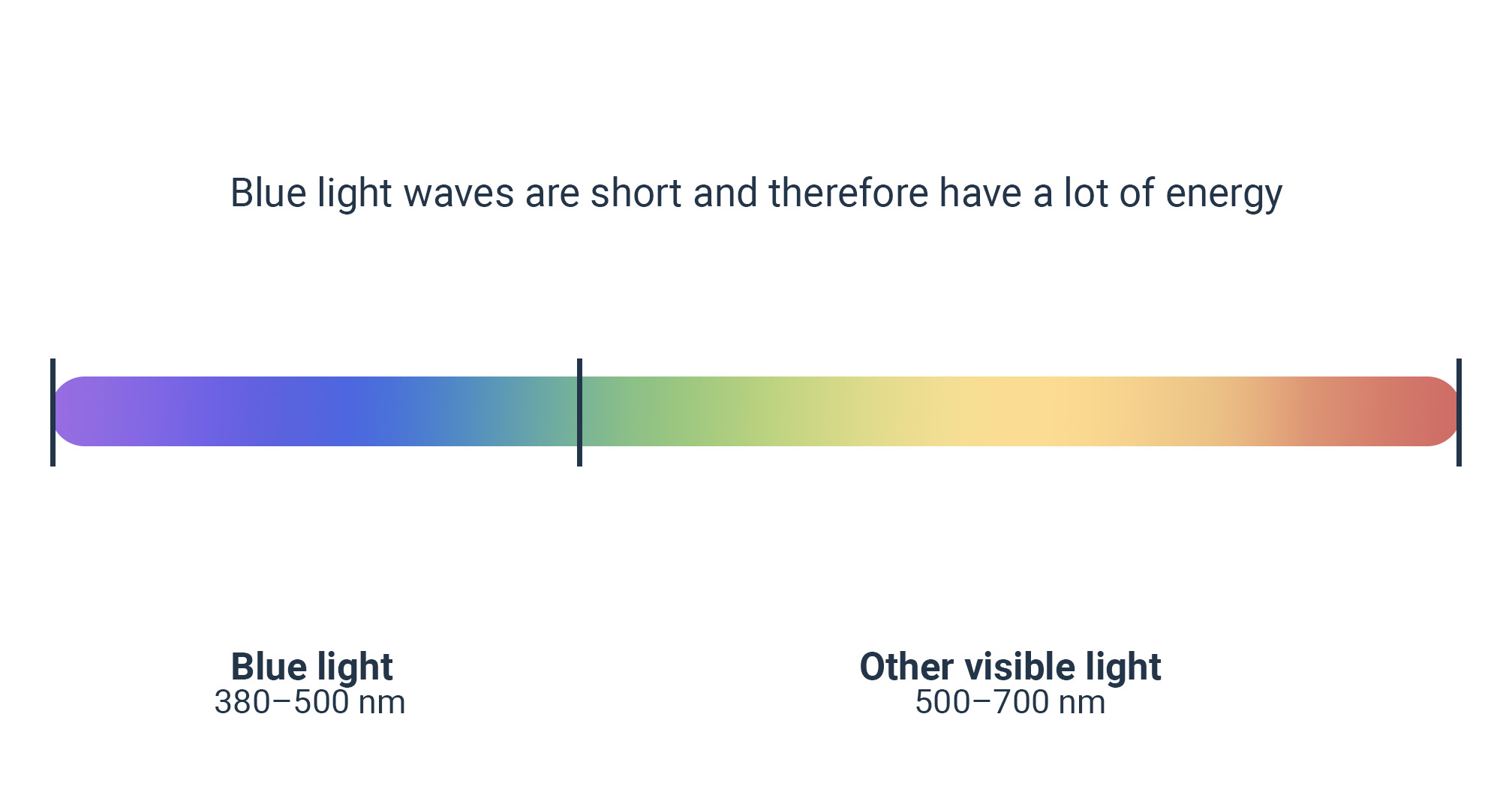What is blue light and is it bad for your eyes?

Table of contents
Blue light, a term we often hear but may not fully understand, is present in our everyday lives. From mobile phone screens, computer monitors, and even the sun itself, blue light emanates from a multitude of sources.
So what is blue light and is it bad for your eyes? While there's no conclusive answer regarding if blue light is inherently bad for our eyes, its knock-on effects might surprise you.
The opticians at Lentiamo are here to break down the concept of blue light in simple terms. We're exploring its most prevalent sources, delving into the associated potential risks and benefits, and providing practical guidance on how to be mindful of our exposure to blue light moving forward.
What is blue light?
Blue light is a portion of visible light. It falls within the visible light portion of the electromagnetic spectrum. It can be both beneficial and potentially harmful to our eyes and overall well-being.
Its wavelength ranges from 380 to 500 nm, meaning blue light has a high energy frequency. Simply put, short-wavelength, high-energy light is known for its ability to penetrate matter more deeply than longer wavelengths. This raises the question of if blue light is damaging.
You can see blue light waves at one end of the light wave spectrum in the image below.

Where does blue light come from?
While the sun is the primary source of natural blue light, digital devices such as computers, mobile phones, fluorescent lighting, and LED TVs emit significant amounts of artificial blue light.
We're continually exposed to varying amounts of blue light throughout the day and night. Our increasing dependence on digital screens and artificial lighting in our daily routines makes it practically unavoidable.
Other types of light
Interestingly, only a small portion of light can be seen by the human eye. The familiar colours of the rainbow – red, orange, yellow, green, blue, indigo, and violet – make up the "visible light" range within the electromagnetic spectrum.
Beyond this, there are lower-energy waves, including microwaves, radio waves, and infrared rays. There are also higher-energy waves, including ultraviolet, X-rays, and gamma rays. None of these are seen by the naked eye.
Did you know? Understanding the diverse properties and applications of different types of light is essential in various scientific, industrial, and everyday contexts. Studying them allows us to harness their benefits while minimising potential risks. Research on the relationship between blue light and our eyes is ongoing.
What does blue light do to your eyes?
Blue light plays a complex role in our visual health. Particularly in the context of digital screens and artificial lighting, it can lead to various risks. Prolonged exposure to devices emitting blue light can strain our eyes and result in symptoms like eye fatigue, dryness, and headaches.
Blue light from the sun is also a necessary part of visual health and the regulation of physiological functions like wakefulness and sleep.
Read more about the benefits and potential risks blue light poses below.
Risks of blue light

Excessive exposure to blue light, especially from screens, can potentially have adverse effects on our eyes and overall health. Here are some risks to consider:
Sleep
Particularly in the evening, exposure to blue light can impact the production of melatonin, a hormone responsible for regulating sleep. This disruption of natural circadian rhythms can affect both the duration and quality of our rest.
In turn, disrupted circadian rhythms can contribute to sleep disorders and can potentially increase the risk of certain cancers.
Experts often recommend putting away electronic devices two hours before bedtime to promote better sleep quality.1
When seeking to understand if blue light causes cancer, it's important to clarify that blue light itself is not known to be cancerous. However, one study has shown that prolonged exposure to high-intensity blue light, especially at night, can disrupt our circadian rhythm which can potentially increase the risk of breast, prostate, and colorectal cancers.2
Digital eye strain
Prolonged screen time can lead to digital eye strain, a condition that can cause discomfort and vision problems. Blue light itself is not shown to be responsible for these symptoms. However, our relation to screens and our usage patterns are contributing factors.
Macular degeneration
Macular degeneration (AMD) is a condition that affects the central part of the retina, which can lead to a loss of central vision.
Research indicates that blue light exposure from sunlight can increase the risk of macular degeneration and worsen its progression.3 However, studies specifically linking AMD and blue light from electronic devices are inconclusive.
Did you know? Macular degeneration is a leading cause of vision loss in older adults. It's detected and monitored using an Amsler grid test.
Risks for children
It's worth noting that children and adults may respond differently to blue light exposure. Sunlight is vital for kids' eye development. Spending less time outside and more time using computers and reading up close increases myopia risk in children by age nine, as seen in a Dutch study of over 5,000 children born between 2002 and 2006.4
So while research is still being conducted about blue light's effects on children's eyes, minimising screen time for children might be advisable. Always consult your healthcare provider for personalised guidance on what's best for you or your children to ensure healthy eye development and vision.
Benefits of blue light
While we hear a lot about its negative effects, blue light is also a necessary part of our daily lives. It's a natural component of sunlight and plays a vital role in regulating our body's biological functions. Key benefits of blue light include:
- Boosting alertness
- Helping memory and brain function
- Elevating mood
- Regulating the body's natural sleep-wake cycle (circadian rhythm)
How to limit blue light
To mitigate the potential adverse effects of excess blue light, you can take the following steps:
- Screen time reduction: Limit screen time, especially before bedtime, to improve sleep quality.
- Night mode: Many electronic devices have a "night mode" or "blue light filter" that reduces the blue light emitted.
- Adjust screen brightness: Lower the brightness of your screens to reduce blue light exposure.
- Use task lighting: To reduce contrast and glare, add soft, indirect lighting to your workspace. This can help reduce the strain on your eyes while working on your computer.
- Regular breaks: Take short breaks during screen use to rest your eyes.
- Blue light glasses: Consider using blue light glasses that filter out harmful blue light. They can be particularly helpful for individuals who spend extended hours in front of screens.
Looking to protect your eyes?
Browse a wide selection of high-quality blue light glasses now
Closing thoughts from Lentiamo
In conclusion, blue light plays a crucial role in our daily lives, from its natural source in sunlight to its presence in digital screens and artificial lighting. It can also lead to potential risks.
While its effects on our eyes, sleep, and overall well-being are multifaceted, it's important to understand and manage our exposure. Striking a balance between benefiting from blue light and protecting our health is key.
Read more
Sources
1. Harvard Health Publishing, No more counting sheep: Proven behaviors to help you sleep
2. Environmental Health Perspectives, Evaluating the Association between Artificial Light-at-Night Exposure and Breast and Prostate Cancer Risk in Spain (MCC-Spain Study)
3. National Library of Medicine, Macular degeneration: peculiar sunlight exposure in an agricultural worker
4. National Library of Medicine, The impact of computer use on myopia development in childhood: The Generation R study








Comments